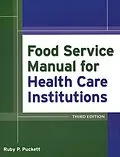Food Service Manual for Health Care Institutions offers a comprehensive review of the management and operation of health care food service departments. This third edition of the book--which has become the standard in the field of institutional and health care food service--includes the most current data on the successful management of daily operations and includes information on a wide variety of topics such as leadership, quality control, human resource management, communications, and financial control and management. This new edition also contains information on the practical operation of the food service department that has been greatly expanded and updated to help institutions better meet the needs of the customer and comply with the regulatory agencies' standards.
Autorentext
Ruby P. Puckett, MA, RD, FCSI, CFE is program director of Dietary Manager Training in the division of continuing education at the University of Florida, Gainesville. She is president of Foodservice Management Consultants and the recipient of the Marjorie Hulsizer Copher award, the highest honor bestowed on an individual RD by the American Dietetic Association.
Klappentext
Food Service Manual for Health Care Institutions offers a comprehensive review of the management and operation of health care food service departments. This third edition of the bookwhich has become the standard in the field of institutional and health care food serviceincludes the most current data on the successful management of daily operations and includes information on a wide variety of topics such as leadership, quality control, human resource management, communications, and financial control and management. This new edition also contains information on the practical operation of the food service department that has been greatly expanded and updated to help institutions better meet the needs of the customer and comply with the regulatory agencies' standards.
A practical and comprehensive resource, Food Service Manual for Health Care Institutions contains information for
- Developing effective food service policies and procedures
- Understanding the advantages and disadvantages of working with contract management companies
- Managing participative leadership and ongoing change
- Using benchmarking and total quality management in food service management as quality improvement tools
- Creating tools for effective communications and time management
- Understanding the most current federal laws and accrediting agencies
- Hiring, training, and evaluating performance of personnel and developing competence-based job descriptions
- Dealing with microbiological hazards and emerging pathogens, food-borne illnesses and causes, sanitation and cleaning of equipment, as well as outlining Hazard Analysis Critical Control Point (HACCP) principles
- Maintaining a safe and ergonomically sound work area and the latest information available on disaster and emergency preparedness
- Developing an individualized plan for the food service operation
- Creating customer menus and information about product selection and purchasing and suggestions about and safety procedures for receiving, storage, and inventory practices
- Producing food that meets the nutritional needs of the customer
In addition, the book is filled with forms, formulas, policies, techniques, and references that will prove invaluable in managing food service in the complex arena of the health care environment. The first two editions of Food Service Manual for Health Care Institutions were published by AHA/ASHFSA.
Inhalt
Figures, Tables, and Exhibits.
Foreword.
Preface.
Acknowledgments.
About the Author.
Introduction.
Chapter 1. Food Service Industry: An Overview.
Part One. Management of the Food Service Department
Chapter 2. Leadership: Managing for Change.
Chapter 3. Marketing.
Chapter 4. Quality Management.
Chapter 5. Planning and Decision Making.
Chapter 6. Organization and Time Management.
Chapter 7. Communication.
Chapter 8. Human Resource Management.
Chapter 9. Clinical Nutrition Care Management.
Chapter 10. Management Information Systems.
Appendix 10.1. Glossary of Computer Terms for Food Service Operators.
Chapter 11. Control Function and Financial Management.
Part Two. Operation of the Food Service Department
Chapter 12. Environmental Issues and Waste Management.
Chapter 13. Food Safety, Sanitation, and Hazard Analysis Critical Control Points.
Chapter 14. Safety, Security, and Emergency Preparedness.
Chapter 15. Menu Planning.
Chapter 16. Product Selection.
Chapter 17. Purchasing.
Chapter 18. Receiving, Storage, and Inventory Control.
Chapter 19. Food Production.
Appendix 19.1. A Culinary Glossary.
Chapter 20. Distribution and Service.
Chapter 21. Facility Design and Equipment Selection.
Index.
